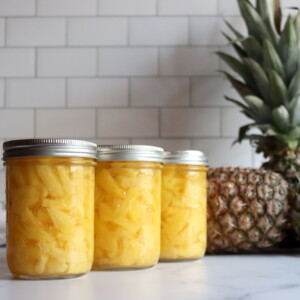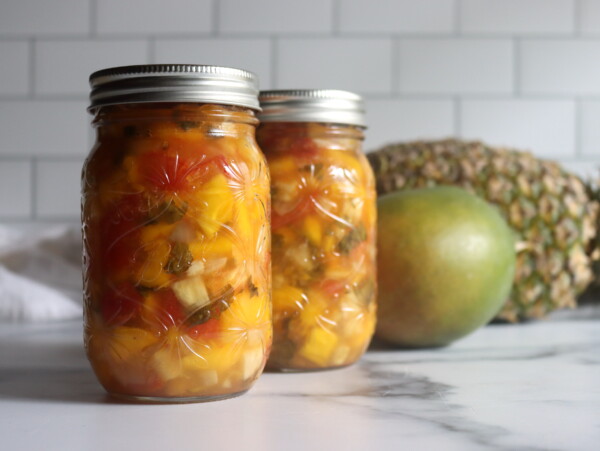This post may contain affiliate links. Please see our disclosure policy.
Canning pineapple is a great way to preserve the tropical flavor of this vibrant fruit, allowing you to enjoy it all year round. Home-canned pineapple tastes a lot better than the store-bought tinned stuff, and my kids eat the fruit right out of the jar!

I know, no one’s exactly growing pineapple in the backyard, and it’s not likely that you’ve got a bumper crop from your garden to put up.
So why can pineapple?
Because it tastes amazing!
Pineapple is one of my favorite things to can each year, and the flavor of home canned pineapple is completely different than the storebought stuff.
When you’re buying cans of pineapple, they’re tossing in whatever low quality or underripe fruit that they know they can’t sell in the produce section. People notice, of course, and Del Monte actually started selling a premium version of “Deluxe Gold Canned Pineapple” that costs 4 times as much, but actually uses mostly ripe pineapple so it comes out yellow instead of a washed-out almost white color.
It’s better, but still nowhere near as good as home-canned pineapple.
Why?
The home-canned stuff is in glass!
The acid in pineapple reacts with the metal in cans and gives the finished product a “tinned” favor. (That’s on reason you’ll always see cucumber pickles in glass, as the acidity pulls flavor from metal cans. The same thing happens when canning pineapple and canning pineapple juice.)
Home canned pineapple tastes sweet, juicy and fresh, and it’s well worth it to buy a few cases of pineapple and make your own.
I like to buy pineapples in April, as that’s peak season, and they usually go on sale for 99 cents each. I’ll get a few cases for canning, and put up this recipe, along with creative recipes for home canned pineapple mango salsa, spicy pickled pineapple and warm cinnamon spiced pickled pineapple at the same time.

Ingredients for Canning Pineapple
- Pineapples: Firm, ripe pineapples are best. You’ll need about 21 pounds of fresh fruit for a canner load of 7 quarts or 13 pounds for 9 pints. On average, it takes about 3 pounds of pineapple per quart jar.
- Syrup or Liquid for Packing: You can pack the pineapple in water, pineapple juice, apple juice, white grape juice, or your choice of syrup (light, medium, or very light).
- Canning Jars and Lids: Make sure your jars are clean and in good condition. You’ll also need new lids to ensure a proper seal.
- A Boiling Water Canner: This will be necessary for processing your jars once they’re filled.
Personally, I like to can pineapple in its own juice, which gives the best flavor, in my opinion. You can use a juicer to juice one of your pineapples, or you can simmer the pineapple cores in a bit of extra light syrup to extract their flavor.
If juicing, I’ve found that you need about one sacrificial juice pineapple for every 6 you intend to can. Simmering the cores is a bit more economical, as you can put up all the pieces of pineapple and just leave out the tough cores.
If you’re canning in a sugar syrup, here are the instructions and amounts for making syrups for canning. I’d suggest extra light syrup, as pineapple is already quite sweet.
With extra light syrup, for a 9 pint canner batch, you’ll need 6 ½ cups of pineapple juice or water, and ¾ cups sugar.

Instructions for Canning Pineapple
Start by washing your pineapples thoroughly. Peel off the tough outer skin and remove any eyes (the hard, spiky bits) using a paring knife. Cut out the tough core, then slice or cube the pineapple into bite-sized pieces. (Save the core for making “juice” to can your pineapple pieces.)
To make juice from the cores, add the cores to a saucepan and cover with water. Simmer for about 10 minutes, then strain. You can add sugar if you’d like, and I’d suggest the amounts for extra light syrup (for a 9 pint canner batch, you’ll need 6 ½ cups of pineapple juice or water, and ¾ cups sugar).
In a large saucepan, add the pineapple to your chosen syrup, water, or juice. Heat the mixture and allow it to simmer for about 10 minutes to soften the pineapple slightly and allow the flavors to blend.
Pineapple doesn’t do well as a raw pack, since the tissues are so full of air. Simmering it for 10 minutes drives off the air, and actually ensures that the pineapple stays intact during canning. If raw packed directly into jars, the pineapple tends to bust apart in the canner.
While the pineapple is simmering, prepare your canning jars. Ladle the hot pineapple pieces into the jars, leaving about a 1/2-inch headspace. Be sure to add enough of the cooking liquid to cover the fruit completely, again leaving the 1/2-inch headspace.
Wipe the rims of the jars with a clean cloth to ensure they’re free of any residue, and then place the lids on top. Secure the jars with the rings, tightening them just until they’re fingertip tight—not overly tight, as this could prevent proper sealing.
Now, it’s time to process your jars in the boiling water canner. Make sure the water is at a rolling boil before adding your jars. Refer to the chart below for processing times based on your elevation.

Processing Times for Canning Pineapple
The processing times below are for boiling-water canning. Adjust your processing times based on your elevation:
| Jar Size | 0 – 1,000 ft | 1,001 – 3,000 ft | 3,001 – 6,000 ft | Above 6,000 ft |
|---|---|---|---|---|
| Pints | 15 minutes | 20 minutes | 20 minutes | 25 minutes |
| Quarts | 20 minutes | 25 minutes | 30 minutes | 30 minutes |
All of these times are for hot pack, and the pineapple should be heated in the syrup before being loaded into the canning jars.
Once the processing time has elapsed, carefully remove the jars from the water and let them cool on a towel-lined counter. You should hear the pop of the jars sealing as they cool.
Pineapple Canning Recipes
Tips for Success:
- Use Ripe but Firm Pineapple: Avoid overly soft or under-ripe fruit. Pineapples that are too soft will not hold up well in the canning process, while under-ripe fruit may lack the sweetness you’re looking for.
- Juicing Tip: If you don’t want to juice a whole pineapple, try simmering the cores to extract a natural juice, which adds great flavor and reduces waste.
- Adjust for Elevation: The altitude you live at affects the boiling point of water, so be sure to adjust your processing time accordingly to ensure proper sealing and food safety.
- Headspace Matters: Don’t forget to leave ½-inch headspace in your jars to allow for expansion during the canning process.
- Storage: Once canned, your pineapple can be stored in a cool, dark place and will maintain peak quality for 12-18 months. Check seals before storing.

Canning Pineapple
Ingredients
- 13 lbs Pineapple, About 1 1/2 lbs per pint jar for a 9 pint batch
- Canning liquid, you choice of: Water, pineapple juice, apple juice, grape juice or sugar syrup
Instructions
- Wash the pineapples thoroughly. Peel off the tough outer skin and remove the spiky eyes with a paring knife. Remove the core, then slice or cube the pineapple into bite-sized pieces. Set aside the cores for juice.
- To create your own juice, simmer the cores in a saucepan with enough water to cover them. Let it simmer for 10 minutes, then strain the mixture. Add sugar if desired. For the recommended extra light syrup, use 6 ½ cups of juice and ¾ cup of sugar for a 9-pint batch.
- In a large saucepan, add the prepared pineapple pieces to your chosen syrup, juice, or water.Heat the mixture to a simmer and cook for 10 minutes to help soften the pineapple and eliminate air pockets (this is key to keeping the fruit intact during canning).
- While the pineapple is simmering, sterilize your canning jars. Ladle the hot pineapple pieces into the jars, leaving ½-inch headspace. Pour in enough of the hot syrup or juice to cover the fruit, again leaving the ½-inch headspace.
- Wipe the rims of the jars with a clean cloth to ensure there is no food residue. Place the lids on top and secure them with canning rings, tightening them just until fingertip-tight (don’t overtighten, as this can affect the seal).
- Fill a boiling water canner with water and bring it to a rolling boil. Carefully lower the jars into the canner and process them according to the altitude chart below. Standard process times for below 1,000 feet in elevation are 15 minutes for pints and 20 minutes for quarts.
- After processing, carefully remove the jars from the canner and allow them to cool on a towel-lined surface.
- Once cool, check the seals by pressing down in the center of the lid—if it doesn’t pop back, the jar has sealed properly.
Store sealed jars in a cool, dark, and dry place. Enjoy your home-canned pineapple does not spoil so long as the jars are sealed, but the quality is best within the first 12-18 months. Refrigerate after opening.
Notes
Yield
You’ll need about 21 pounds of fresh fruit for a canner load of 7 quarts or 13 pounds for 9 pints. On average, it takes about 3 pounds of pineapple per quart jar, or roughly 1 1/2 pounds of pineapple per pint (weighed as purchased).Syrup or Liquid for Packing
You can pack the pineapple in water, pineapple juice, apple juice, white grape juice, or your choice of syrup (light, medium, or very light). If making syrup, I suggest using extra light syrup as pineapple is already quite sweet. To make enough extra light syrup for a canner batch of 9 pints, you’ll need 6 1/2 cups water and 3/4 cups sugar. For a canner batch of 7 quarts, you’ll need 10 1/2 cups water and 1 1/4 cups sugar.Pineapple Canning Altitude Adjustments
The altitude adjustments for water bath canning pineapple are as follows:- For Under 1,000 Feet in Elevation – 15 minutes for pints, 20 minutes for quarts
- For 1,001 to 3,000 Feet in Elevation – 20 minutes for pints, 25 minutes for quarts
- For 3,001 to 6,000 Feet in Elevation – 20 minutes for pints, 30 minutes for quarts
- Above 6,001 Feet in Elevation – 25 minutes for pints, 35 minutes for quarts
Nutrition
Nutrition information is automatically calculated, so should only be used as an approximation.
Pineapple Canning Recipes
Need a few more ways to preserve pineapple?
Fruit Canning Recipes
Looking for more ways to preserve fruit in a jar?






Excellent